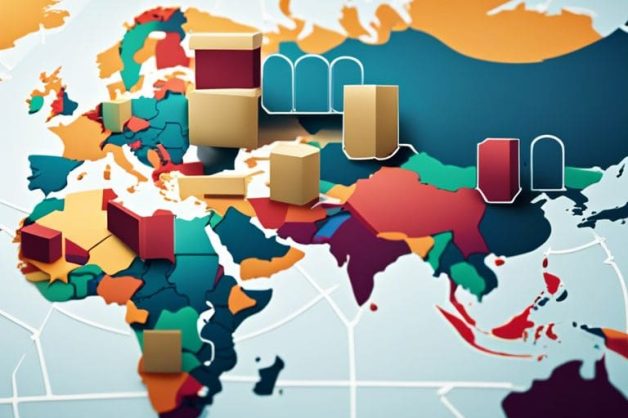Free trade areas (FTAs) are pivotal in shaping international trade by reducing or eliminating trade barriers between member countries. These areas facilitate economic integration and enhance trade by promoting the free movement of goods, services, and investments. Understanding the legal aspects of free trade areas is crucial for businesses and legal professionals navigating the complexities of global markets.
Types of Free Trade Areas
Free trade areas can be broadly classified into bilateral and multilateral agreements. Bilateral free trade agreements are negotiated between two countries, aiming to reduce tariffs and other trade barriers to foster economic cooperation. An example is the United States-South Korea Free Trade Agreement (KORUS FTA), which enhances trade and investment flows between the two countries.
Multilateral free trade agreements, on the other hand, involve multiple countries and aim to create a larger free trade zone. An example is the North American Free Trade Agreement (NAFTA), now replaced by the United States-Mexico-Canada Agreement (USMCA), which aims to strengthen trade relations among North American countries. Another example is the European Free Trade Association (EFTA), which promotes free trade among its member states and other countries through a network of free trade agreements.
Legal Framework Governing Free Trade Areas
The legal framework governing free trade areas is complex and involves national laws, international agreements, and regional trade organizations. In the United States, free trade agreements are negotiated and implemented by the Office of the United States Trade Representative (USTR), in coordination with other federal agencies. The Trade Act of 1974 provides the legislative authority for the President to negotiate and enter into trade agreements with other countries.
Internationally, the World Trade Organization (WTO) provides a framework for free trade agreements through its agreements, such as the General Agreement on Tariffs and Trade (GATT) and the General Agreement on Trade in Services (GATS). The WTO’s principles of non-discrimination and transparency apply to free trade areas, ensuring that trade agreements promote fair competition and do not create unnecessary barriers to trade.
Regional trade organizations, such as the European Union (EU) y el Association of Southeast Asian Nations (ASEAN), also play a significant role in governing free trade areas. These organizations establish common trade policies and regulatory frameworks that facilitate economic integration and promote trade among member states.
Economic Impacts of Free Trade Areas
Free trade areas have significant economic impacts, influencing trade flows, investment, and economic growth. By reducing or eliminating tariffs and other trade barriers, FTAs enhance market access for businesses, leading to increased trade and investment flows. For example, the USMCA aims to strengthen trade relations among North American countries by reducing tariffs and promoting the free movement of goods, services, and investments.
Free trade areas also promote economic integration, leading to the creation of larger markets and increased competition. This can result in efficiency gains, innovation, and lower prices for consumers. Additionally, FTAs can attract foreign direct investment (FDI) by providing a stable and predictable trading environment. For instance, the European Union has attracted significant FDI due to its integrated market and common regulatory framework.
However, free trade areas can also pose challenges. They can lead to increased competition for domestic industries, potentially resulting in job losses and economic disruption. Additionally, the benefits of FTAs may not be evenly distributed, with some sectors and regions gaining more than others. Policymakers must carefully consider these impacts when negotiating and implementing free trade agreements.
Key Legal Cases and Precedents
Several key legal cases and precedents have shaped the current understanding and enforcement of free trade areas. One notable case is the EC – Bananas dispute. This case involved the European Union’s preferential treatment of banana imports from former European colonies. The WTO ruled that the EU’s banana regime violated principles of non-discrimination, prompting significant changes in the EU’s trade policies.
Another important case is the US – Steel and Aluminum Tariffs dispute. In 2018, the United States imposed tariffs on steel and aluminum imports, citing national security concerns. Several countries challenged these tariffs at the WTO, arguing that they were unjustified and violated international trade rules. The case highlighted the complexities of balancing national security interests with free trade principles.
These cases underscore the importance of the WTO’s dispute resolution mechanism in addressing trade conflicts and ensuring compliance with international trade regulations. Legal professionals must stay abreast of these developments to provide accurate and timely advice to their clients.
Comparative Analysis of Free Trade Areas
The landscape of free trade areas varies significantly across different regions and countries. The European Union (EU), for example, has established a highly integrated trade bloc with harmonized regulations and a common external tariff. The EU’s free trade agreements often include provisions on labor rights, environmental standards, and sustainable development, reflecting the bloc’s commitment to high regulatory standards.
Por el contrario, China has pursued a more flexible approach to free trade agreements, focusing on bilateral and regional deals that enhance its strategic interests. China’s free trade agreements often emphasize market access and economic cooperation, with measures to encourage domestic production and innovation. However, China’s regulatory environment can also pose challenges for foreign businesses, including complex customs procedures and technology transfer requirements.
The United States has adopted a mix of bilateral and multilateral free trade agreements, often emphasizing reciprocal market access and the protection of intellectual property rights. Recent agreements, such as the USMCA and the United States-Japan Trade Agreement, reflect the country’s focus on modernizing trade rules and addressing issues such as digital trade and labor standards.
Understanding these different approaches to free trade areas is essential for businesses and legal professionals involved in international trade. Comparative analysis can provide valuable insights into the strengths and weaknesses of various trade agreements, helping stakeholders make informed decisions.
Policy Implications and Recommendations
Free trade areas have significant policy implications, influencing economic growth, international relations, and global trade dynamics. Policymakers must carefully consider these implications when negotiating and implementing free trade agreements. One key recommendation is to promote transparent and inclusive trade negotiations. Ensuring that trade negotiations are conducted openly and involve a broad range of stakeholders can enhance the legitimacy and effectiveness of trade agreements.
Another recommendation is to balance trade liberalization with regulatory protections. While reducing trade barriers can promote economic growth, it is also important to maintain high standards for labor rights, environmental protection, and consumer safety. Trade agreements should include provisions that address these issues and promote sustainable development.
Additionally, policymakers should consider the long-term impacts of free trade areas on different sectors of the economy. While some industries may benefit from increased market access, others may face challenges due to increased competition. A balanced approach that considers the needs and interests of various stakeholders is crucial for achieving positive outcomes from free trade agreements.
Stakeholder Perspectives on Free Trade Areas
Various stakeholders have different perspectives on free trade areas, reflecting their unique interests and concerns. Businesses often view free trade areas as opportunities to expand market access and enhance competitiveness. They advocate for the reduction or elimination of tariffs, quotas, and non-tariff barriers to facilitate free trade and optimize supply chains.
Government agencies have a more nuanced perspective, balancing the need to protect domestic industries and jobs with the benefits of free trade. They may implement free trade agreements to promote economic growth, enhance international cooperation, and achieve strategic objectives.
Non-governmental organizations (NGOs) y consumer groups often focus on the social and environmental impacts of free trade areas. They advocate for trade policies that prioritize public welfare, ethical considerations, and sustainable development. These stakeholders may support trade agreements that include strong labor and environmental provisions while opposing those that prioritize economic interests over social and environmental concerns.
Practical Applications and Industry Impact
Free trade areas have practical applications and impacts across various industries. In the technology sector, free trade agreements that address issues like intellectual property protection and digital trade can significantly influence market access and innovation. Tech companies must navigate these agreements to ensure compliance and optimize their global operations.
In the agriculture industry, free trade agreements that reduce tariffs and harmonize sanitary regulations can enhance export opportunities and improve supply chain efficiency. Farmers and agribusinesses must stay informed about the terms of trade agreements to maximize their benefits and comply with regulatory requirements.
En automotive industry also experiences significant impacts from free trade areas. Tariffs on vehicles and components, as well as regulations on emissions and safety standards, can affect production costs and market competitiveness. Automotive manufacturers must adapt to these trade agreements to maintain their competitive edge in the global market.
Future Outlook and Emerging Trends
The future of free trade areas is shaped by several emerging trends and developments. One notable trend is the increasing focus on digital trade. As e-commerce and digital services continue to grow, countries are negotiating free trade agreements that address issues like data privacy, cybersecurity, and digital taxation. These digital trade agreements aim to create a more predictable and secure environment for digital commerce.
Another emerging trend is the emphasis on sustainable trade policies. With growing concerns about climate change and environmental protection, countries are incorporating sustainability criteria into their trade regulations. This includes measures like carbon tariffs, environmental standards, and green procurement policies. Sustainable trade regulations aim to promote environmentally friendly practices and support the transition to a low-carbon economy.
Ethical Considerations in Free Trade Areas
Free trade areas also raise important ethical considerations. The negotiation and implementation of these agreements can impact various stakeholders, including workers, consumers, and communities. Ensuring that free trade agreements are fair, transparent, and inclusive is crucial for addressing ethical concerns.
One key ethical consideration is the protection of labor rights. Trade regulations should include provisions that promote fair labor practices, prevent exploitation, and ensure safe working conditions. This can help protect workers’ rights and promote social justice.
Another ethical consideration is the promotion of environmental sustainability. Trade regulations should include measures that encourage environmentally friendly practices, reduce carbon emissions, and protect natural resources. This can help address the global challenge of climate change and promote sustainable development.
Cumplimiento y buenas prácticas
Businesses must adopt best practices to ensure compliance with free trade agreements. This includes conducting thorough market research y diligencia debida to understand the terms and conditions of trade agreements. Companies should also engage in advocacy and lobbying to influence trade policies and reduce barriers.
Legal professionals play a critical role in helping businesses navigate compliance issues. They provide expert advice on international trade laws, represent clients in trade disputes, and assist with contract negotiation and drafting. By incorporating provisions to address potential trade barriers, such as force majeure clauses, legal professionals help protect businesses from legal and financial risks.
In conclusion, free trade areas are a complex and multifaceted aspect of international trade. They can promote economic growth and enhance international cooperation but also pose significant challenges. Legal professionals play a vital role in navigating these agreements, providing expert advice, representing clients in disputes, and ensuring compliance with international trade laws. By understanding the types, legal frameworks, economic impacts, case studies, strategies, and future trends of free trade areas, businesses can effectively manage their global trade operations and achieve success in the international market.









